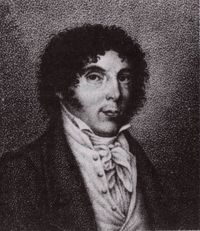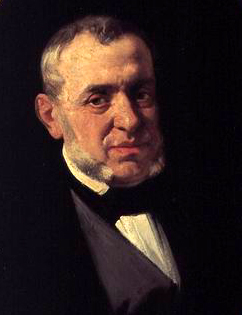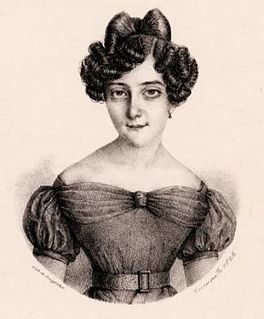Related Research Articles

Felice Romani was an Italian poet and scholar of literature and mythology who wrote many librettos for the opera composers Donizetti and Bellini. Romani was considered the finest Italian librettist between Metastasio and Boito.
Marco Lazzara is an Italian countertenor who sings a wide-ranging repertoire from baroque composers to those of the 20th century and has performed in a number of notable premieres and revivals of rarely performed operas. He has recorded widely on the Bongiovanni, Ricordi, Nuova Era, Forlane, Opera Rara and Dynamic labels.
Tomaso Benvenuti was a nineteenth-century Italian composer of opera. He was born in Cavarzere in the Veneto and died in Rome at the age of 68.
Elisa Orlandi (1811–1834) was an Italian opera singer who was active at major opera houses in Italy from 1829 until her sudden death in 1834. Possessing a wide vocal range with a significant amount of coloratura facility, she tackled roles from both the mezzo-soprano and soprano repertoires. She is best remembered today for portraying the role of Giovanna Seymour in the world premiere of Gaetano Donizetti's Anna Bolena in 1830.

Antonio Cagnoni was an Italian composer. Primarily known for his twenty operas, his work is characterized by his use of leitmotifs and moderately dissonant harmonies. In addition to writing music for the stage, he composed a modest amount of sacred music, most notably a Requiem in 1888. He also contributed the third movement, Quid sum miser, to the Messa per Rossini, a collaborative work created by thirteen composers to honor Gioacchino Rossini.
Marietta Sacchi was an Italian operatic soprano who had an active career during the 1820s and 1830s. She mainly performed in comprimario and soubrette roles, and appeared at most of Italy's major opera houses and at His Majesty's Theatre in London. She notably created roles in the world premieres of operas by Vincenzo Bellini, Gaetano Donizetti, Simon Mayr, Giovanni Pacini, Luigi Ricci, and Giuseppe Verdi. She also excelled in parts from the operas of Gioachino Rossini.
Teresa Ruggeri was an Italian operatic soprano who had an active career from the 1820s through the 1840s. In 1827 she portrayed the role of Zarele in the world premiere of Giovanni Pacini's Gli arabi nelle Gallie at La Scala in Milan. She performed in several more world premieres at that house, including Francisca in Gaetano Donizetti's Maria Padilla (1841), Anna in Giuseppe Verdi's Nabucco (1842), and Viclinda in Verdi's I Lombardi alla prima crociata (1843). Other roles she performed at La Scala included Baroness Aspasia in Gioachino Rossini's La pietra del paragone (1829), Giannetta in Donizetti's L'elisir d'amore (1835), Alisa in Donizetti's Lucia di Lammermoor (1839), The Marquise of Birkenfeld in La fille du régiment (1840), and Giovanna in Verdi's Ernani (1844) among others.

Stefano Pavesi was an Italian composer.

Salvator Rosa is an opera seria in four acts composed by Antônio Carlos Gomes to a libretto in Italian by Antonio Ghislanzoni. It premiered at the Teatro Carlo Felice in Genoa on 21 March 1874. The plot is based on Eugène de Mirecourt's 1851 adventure novel, Masaniello, in turn loosely based on the lives of the Italian painter and poet, Salvator Rosa and Masaniello, a Neapolitan fisherman, who became leader of the 1647 revolt against the Spanish Habsburg rule in Naples.

Luca Antonio Predieri was an Italian composer and violinist. A member of a prominent family of musicians, Predieri was born in Bologna and was active there from 1704. In 1737 he moved to Vienna, eventually becoming Kapellmeister to the imperial Habsburg court in 1741, a post he held for ten years. In 1765 he returned to his native city where he died two years later at the age of 78. A prolific opera composer, he was also known for his sacred music and oratorios. Although his operas were largely forgotten by the end of his own lifetime and most of their scores lost, individual arias as well some of his sacred music are still performed and recorded.

Elisabetta Manfredini-Guarmani was an Italian opera singer best known for having created the leading soprano roles in four of Rossini's operas, roles which he wrote specifically for her voice. She was born Antonia Elisabetta Manfredini in Bologna and was the daughter of the composer and music theorist Vincenzo Manfredini. After her stage debut in 1810 when she sang in the premiere of Stefano Pavesi's Il trionfo di Gedeone at Bologna's Teatro del Corso, she went on to perform at La Fenice, La Scala, Teatro Regio di Torino, Rome's Teatro Argentina and several other opera houses, primarily in Northern Italy. In addition to the roles she created in Rossini's operas, she also sang in the world premieres of operas by several composers who are lesser known today, including Pietro Raimondi, Simon Mayr, and Ferdinando Paër. Her last known appearance was in 1828 after which there is no further trace of her. The date and place of her death are unknown.

Vincenzo Negrini was an Italian bass-baritone opera singer. Born in Cesena, he sang leading bass and baritone roles in Italy's major opera houses and created several roles in early 19th-century operas, most notably Oroveso in Bellini's Norma and Folco in Donizetti's Ugo, conte di Parigi. Severe heart disease caused him to retire from the stage in June 1840. He died in Milan two months later at the age of 35.
Vincenzo Galli was an Italian opera singer and impresario. Considered an outstanding basso buffo singer, he created many roles on Italian stages, including ones in two of Donizetti's operas: Ivano in Otto mesi in due ore and Cesare Salzapariglia in Le convenienze ed inconvenienze teatrali. Luigi Ricci composed the role of Michelotto in his opera Chiara di Rosembergh specifically for Galli's voice.

Pelagio is an opera in four acts by Saverio Mercadante. The Italian-language libretto was by Marco D'Arienzo. It premiered on 12 February 1857 at the Teatro San Carlo, Naples, to great success.

Caterina Canzi, also known as Katharina Wallbach-Canzi, was an Austrian-born soprano who sang leading roles in the opera houses of Europe, primarily in Italy and Germany. Amongst the roles she created were Isolde in Lindpaintner's Der Vampyr and the title role in Mercadante's Nitocri.
Giovanni Moretti was an Italian composer and conductor active in Naples. He was primarily known for his operas, although he also composed numerous pieces of chamber music, sacred music, and art songs.
Giuseppe Puzone was an Italian opera composer and conductor active in Naples, the city of his birth. He was for many years the principal conductor of the Teatro San Carlo where his opera Elfrida di Salerno had premiered in 1849. He composed three other operas, all of which premiered in Naples, as well as sacred and symphonic music.
Ipermestra is an opera libretto by Pietro Metastasio first set by Johann Adolph Hasse 8 January 1744, and in the November of the same year by Christoff Willibald Gluck.

Maria Ester Mombelli was an Italian opera singer particularly known for her performances in operas by Rossini and Donizetti. She sang both soprano and mezzo-soprano roles, and often sang with her younger sister Anna.

Carolina Bassi was an Italian contralto.
References
- 1 2 Casaglia, Gherardo (2005). Nitocri. Almanacco Amadeus. Retrieved 9 March 2016 (in Italian)
- ↑ Florimo, Francesco (1869). Cenno storico sulla scuola musicale di Napoli, Vol. 1, p. 644. Tipografia di Lorenzo Rocco